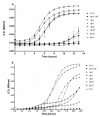Deciphering the Role of Multiple Thioredoxin Fold Proteins of Leptospirillum sp. in Oxidative Stress Tolerance
- PMID: 32164170
- PMCID: PMC7084401
- DOI: 10.3390/ijms21051880
Deciphering the Role of Multiple Thioredoxin Fold Proteins of Leptospirillum sp. in Oxidative Stress Tolerance
Abstract
Thioredoxin fold proteins (TFPs) form a family of diverse proteins involved in thiol/disulfide exchange in cells from all domains of life. Leptospirillum spp. are bioleaching bacteria naturally exposed to extreme conditions like acidic pH and high concentrations of metals that can contribute to the generation of reactive oxygen species (ROS) and consequently the induction of thiol oxidative damage. Bioinformatic studies have predicted 13 genes that encode for TFP proteins in Leptospirillum spp. We analyzed the participation of individual tfp genes from Leptospirillum sp. CF-1 in the response to oxidative conditions. Genomic context analysis predicted the involvement of these genes in the general thiol-reducing system, cofactor biosynthesis, carbon fixation, cytochrome c biogenesis, signal transduction, and pilus and fimbria assembly. All tfp genes identified were transcriptionally active, although they responded differentially to ferric sulfate and diamide stress. Some of these genes confer oxidative protection to a thioredoxin-deficient Escherichia coli strain by restoring the wild-type phenotype under oxidative stress conditions. These findings contribute to our understanding of the diversity and complexity of thiol/disulfide systems, and of adaptations that emerge in acidophilic microorganisms that allow them to thrive in highly oxidative environments. These findings also give new insights into the physiology of these microorganisms during industrial bioleaching operations.
Keywords: Leptospirillum sp. CF-1; bioleaching; oxidative stress; thioredoxin; thioredoxin fold proteins.
Conflict of interest statement
The authors declare no conflict of interest.
Figures



Similar articles
-
The Thioredoxin Fold Protein (TFP2) from Extreme Acidophilic Leptospirillum sp. CF-1 Is a Chaperedoxin-like Protein That Prevents the Aggregation of Proteins under Oxidative Stress.Int J Mol Sci. 2024 Jun 24;25(13):6905. doi: 10.3390/ijms25136905. Int J Mol Sci. 2024. PMID: 39000017 Free PMC article.
-
A novel gene from the acidophilic bacterium Leptospirillum sp. CF-1 and its role in oxidative stress and chromate tolerance.Biol Res. 2022 May 7;55(1):19. doi: 10.1186/s40659-022-00388-0. Biol Res. 2022. PMID: 35525996 Free PMC article.
-
Thiol/Disulfide system plays a crucial role in redox protection in the acidophilic iron-oxidizing bacterium Leptospirillum ferriphilum.PLoS One. 2012;7(9):e44576. doi: 10.1371/journal.pone.0044576. Epub 2012 Sep 6. PLoS One. 2012. PMID: 22970253 Free PMC article.
-
The thioredoxin antioxidant system.Free Radic Biol Med. 2014 Jan;66:75-87. doi: 10.1016/j.freeradbiomed.2013.07.036. Epub 2013 Jul 27. Free Radic Biol Med. 2014. PMID: 23899494 Review.
-
Thioredoxins in bacteria: functions in oxidative stress response and regulation of thioredoxin genes.Naturwissenschaften. 2006 Jun;93(6):259-66. doi: 10.1007/s00114-006-0106-1. Naturwissenschaften. 2006. PMID: 16555095 Review.
Cited by
-
Integrated Full-Length Transcriptome and MicroRNA Sequencing Approaches Provide Insights Into Salt Tolerance in Mangrove (Sonneratia apetala Buch.-Ham.).Front Genet. 2022 Jul 11;13:932832. doi: 10.3389/fgene.2022.932832. eCollection 2022. Front Genet. 2022. PMID: 35899202 Free PMC article.
-
Unlocking Survival Mechanisms for Metal and Oxidative Stress in the Extremely Acidophilic, Halotolerant Acidihalobacter Genus.Genes (Basel). 2020 Nov 24;11(12):1392. doi: 10.3390/genes11121392. Genes (Basel). 2020. PMID: 33255299 Free PMC article.
-
Screening of high glucose tolerant Escherichia coli for L-valine fermentation by autonomous evolutionary mutation.Appl Microbiol Biotechnol. 2025 Jan 21;109(1):15. doi: 10.1007/s00253-024-13334-9. Appl Microbiol Biotechnol. 2025. PMID: 39836325 Free PMC article.
-
The Thioredoxin System of Mammalian Cells and Its Modulators.Biomedicines. 2022 Jul 21;10(7):1757. doi: 10.3390/biomedicines10071757. Biomedicines. 2022. PMID: 35885063 Free PMC article. Review.
-
Transcriptomic analysis of chloride tolerance in Leptospirillum ferriphilum DSM 14647 adapted to NaCl.PLoS One. 2022 Apr 29;17(4):e0267316. doi: 10.1371/journal.pone.0267316. eCollection 2022. PLoS One. 2022. PMID: 35486621 Free PMC article.
References
MeSH terms
Substances
Grants and funding
LinkOut - more resources
Full Text Sources
Miscellaneous

